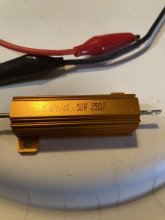FilterGuy
Solar Engineering Consultant - EG4 and Consumers
This is what I do:
https://diysolarforum.com/resources/inverter-disconnect-switch-with-precharge.60/
A couple of notes:
1) I like this better than a push-button because even if you rotate the switch quickly, you will at least partially pre-charge the caps, but it is easy to forget to press the push-button.
2) When I first developed the design in the resource, I was worried about the case where someone leaves the switch on pre-charge *and* has the inverter on. In this case I was worried about a lot of current going through the pre-charge resistors and overheating them. Consequently I put the PTC resisters in to act as a limiting device to prevent any problems. I have since tried this on three different inverters and if you leave the switch on pre-charge while the inverter on, the inverter detects low battery and does not fully turn on. Consequently, the pre-charge resistors never heat up. I am debating whether I should remove the PTC from the design but I don't know if the sample of 3 different inverters are representative of all inverters.. (I did not put the PTC in the last build I did because the inverter I was using did not need it)
https://diysolarforum.com/resources/inverter-disconnect-switch-with-precharge.60/
A couple of notes:
1) I like this better than a push-button because even if you rotate the switch quickly, you will at least partially pre-charge the caps, but it is easy to forget to press the push-button.
2) When I first developed the design in the resource, I was worried about the case where someone leaves the switch on pre-charge *and* has the inverter on. In this case I was worried about a lot of current going through the pre-charge resistors and overheating them. Consequently I put the PTC resisters in to act as a limiting device to prevent any problems. I have since tried this on three different inverters and if you leave the switch on pre-charge while the inverter on, the inverter detects low battery and does not fully turn on. Consequently, the pre-charge resistors never heat up. I am debating whether I should remove the PTC from the design but I don't know if the sample of 3 different inverters are representative of all inverters.. (I did not put the PTC in the last build I did because the inverter I was using did not need it)
Last edited:






